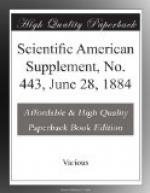[Footnote 2: For instance, the electric properties of crystals can be readily examined in illuminated dusty air; the dust grows on them in little bushes and marks out their poles and neutral regions, without any need for an electrometer. Magnesia smoke answers capitally.]
Surrounding all bodies warmer than the air is a thin region free from dust, which shows itself as a dark space when examined by looking along a cylinder illuminated transversely, and with a dark background. At high temperatures the coat is thick; at very low temperatures it is absent, and dust then rapidly collects on the rod. On a warm surface only the heavy particles are able to settle—there is evidently some action tending to drive small bodies away. An excess of temperature of a degree or two is sufficient to establish this dust-free coat, and it is easy to see the dust-free plane rising from it. The appearances may also be examined by looking along a cylinder toward the source of light, when the dust-free spaces will appear brighter than the rest. A rod of electric light carbon warmed and fixed horizontally across a bell-jar full of dense smoke is very suitable for this experiment, and by means of a lens the dust-free regions may be thus projected on to a screen. Diminished pressure makes the coat thicker. Increased pressure makes it thinner. In hydrogen it is thicker, and in carbonic acid thinner, than in air. We have also succeeded in observing it in liquids—for instance, in water holding fine rouge in suspension, the solid body being a metal steam tube. Quantitative determinations are now in progress.
[Illustration: Fig. 1 and Fig. 2]
Fig. 1 shows the appearance when looking along a copper or carbon rod laterally illuminated; the paths of the dust particles are roughly indicated. Fig. 2 shows the coat on a semi-cylinder of sheet copper with the concave side turned toward the light.
It is difficult to give the full explanation of the dust free spaces in a few words, but we may say roughly that there is a molecular bombardment from all warm surfaces by means of which small suspended bodies get driven outward and kept away from the surface. It is a sort of differential bombardment of the gas molecules on the two faces of a dust particle somewhat analogous to the action on Mr. Crookes’ radiometer vanes. Near cold surfaces the bombardment is very feeble, and if they are cold enough it appears to




